Liberta (2012) has the curious mix of being somewhat refreshing yet thoroughly contrived.
The film, about finding emotional release from depression, unfolds through first-person narration by actress Faye Kingslee. Kingslee acts as a character who struggles to overcome a traumatic past, and attempts to heal by travelling to Ayers Rock in the Australian outback. For much of the film, she speaks to the camera, waxing lyrical about the cycles of depression as she chain-smokes in cafés or walks about Sydney, a place where she feels great unease and wishes to escape from. Her acting is natural, but she often rambles on about herself in superficial ways:
"I don't think I'm a marrying, settling down kind of gal."
"It's not blockage. I have to block it."
These shallow, vapid utterances really don’t help the fact that Kingslee bears little more than slight resemblance to a certain Hollywood actress who is heavily criticised for her superficial acting as protagonist of an over-hyped vampire franchise-flick. 15 minutes into the 80 minutes-long film, I found myself counting the minutes to the end.
 |
| Faye Kingslee |
 |
| Kristen Stewart |
For a film that lacks a concrete plot, the use of an extended first-person monologue is a risk, yet one which director Kan Lume himself deems calculated, as he states in an interview with the Cinémathèque Quarterly, that he “knew this would irritate some audiences…but…some would appreciate time spent listening to an interesting character.”
Yet, watching the film and reading such a statement made me ponder about gender representations on screen. When Kingslee starts to talk about a brief romantic encounter with an Italian critic at a film festival, my eyes start to glaze over, and I thought, “If it was a less attractive girl in front of the camera, would we give her our 50 seconds to hear her natter away aimlessly?” How will our perceptions of depression experienced and articulated by a jet-setting, young, pretty female be different from one less privileged both financially and in appearance? By casting a good-looking actress, will the entire premise of the film become strangely and ironically inaccessible?
Halfway through the film, during her drive to Ayers Rock, she opens up further about the incidents which triggered her sadness. Like getting to know someone for the first time, Faye gradually shares her feelings about a number of traumatic episodes in her past. However, these recollections unfold alongside Are We There Yet? (2005) type white noise:
“Has it gotten really hot in here?”
“Is there petrol left?”
As she drives on, she comments on how the road ahead “just keeps going on and on and on,” and I start to think the same about this movie.
This style of documentary realism built for a story that is partly fictional always presents a double bind for me. Like Lume says, “[t]he film really is a mixture of fact and fiction, reality and dream. It was all planned, yet it was serendipitous.” It’s also an approach that has been embraced by all great documentary auteurs, in one form or another, by the likes of Herzog and Kiarostami. The success of such films is a matter of “chance,” as Lume says, but what I’d prefer to call “blind whacking.” With very few and brief directions for the actor(s) involved, the director films absolute anything for hours, days, and even weeks on end, allowing a somewhat non-existent script to go anywhere it chooses. In other words, recording cheap musings or allowing the actors’ stream of consciousness to take screen time in the hopes that it would ultimately reap and net something of true value; ten minutes of authenticity that would give the film a magical purpose. This style of filmmaking has been especially encouraged in recent times because digital filmmaking does not entail a waste of expensive film footage. With such a method, directors get away with a lot, because even what is construed to be “cheap musings” are often included in the hopes that it would at least build a "mood” alongside much precious, deeply rapturing, sacrosanct dead time.
 |
| Faye packs for her trip to Ayers Rock |
If this film did attempt to capture the thoughts of someone close to suicide, as it states in the opening pretext, fleeting poignancy and pathos in Liberta often gives way to indulgence, and for the most part, is really pure cinematic masturbation, demeaning the pain of going through depression.
 |
| The pool at Ayers Rock where Faye swims with a group of aboriginal kids |
There is a truly special scene which breaks from the monotony—and essentially saves this film from being a pointless, pretentious mess—and it comes at the coda, where Kingslee swims and wrestles with five aboriginal kids near Ayers Rock. There, in cool waters that form an inviting respite from the scorching, parched land, she splashes about tenuously at first, and then slowly, in a manner more carefree, encouraged by the kids around her. Like a baptism of sorts, the episode sets her free, and a few heartfelt interactions with the kids in the beautiful setting become this film’s ten minutes of purpose.
